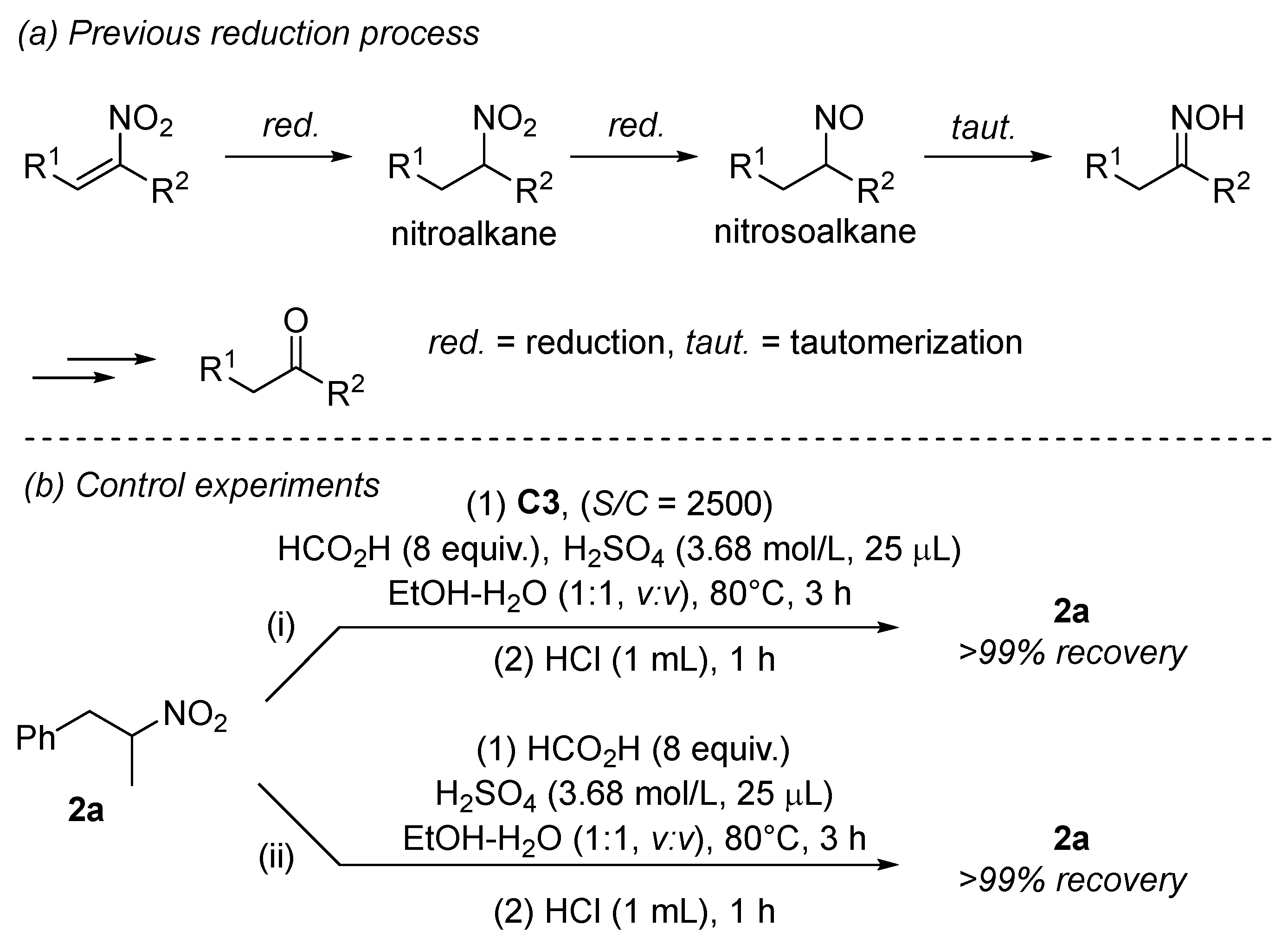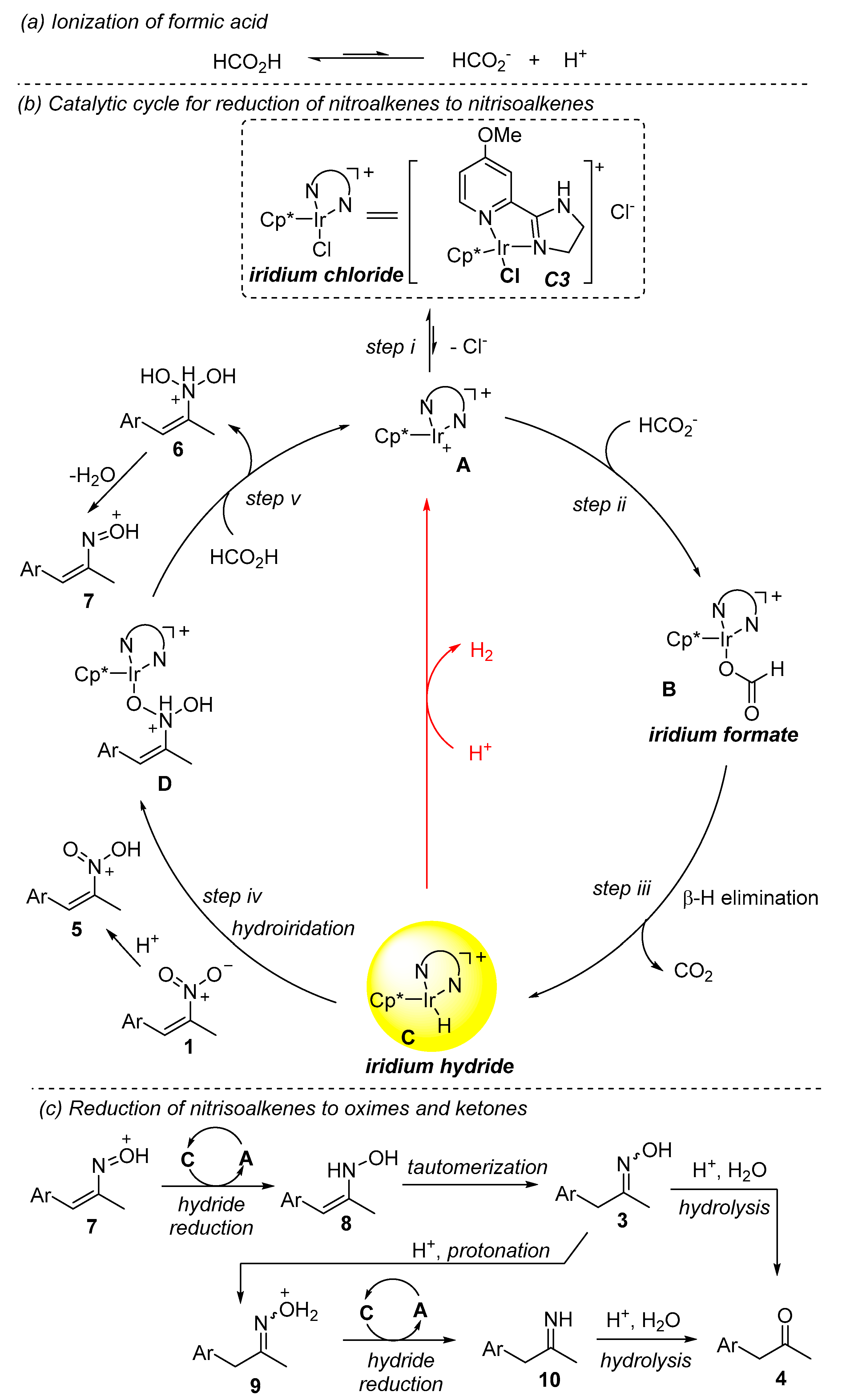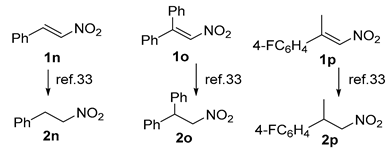Iridium-Catalyzed and pH-Dependent Reductions of Nitroalkenes to Ketones
Abstract
1. Introduction
2. Results and Discussion
3. Materials and Methods
3.1. Materials and Instruments
3.2. General Procedure for Reduction of Nitroalkenes to Ketones
3.2.1. 1-Phenylpropan-2-one (4a)
3.2.2. 1-(4-Methoxyphenyl)propan-2-one (4b)
3.2.3. 1-(4-(Methylthio)phenyl)propan-2-one (4c)
3.2.4. 1-(p-Tolyl)propan-2-one (4d)
3.2.5. 1-(4-Fluorophenyl)propan-2-one (4e)
3.2.6. 1-(4-Chlorophenyl)propan-2-one (4f)
3.2.7. 1-(4-Bromophenyl)propan-2-one (4g)
3.2.8. 1-(4-(Trifluoromethyl)phenyl)propan-2-one (4h)
3.2.9. 4-(2-Oxopropyl)benzonitrile (4i)
3.2.10. 1-(4-Nitrophenyl)propan-2-one (4J)
3.2.11. 1-(4-(Methylsulfonyl)phenyl)propan-2-one (4k)
3.2.12. 1-phenylbutan-2-one (4l)
4. Conclusions
Supplementary Materials
Author Contributions
Funding
Institutional Review Board Statement
Informed Consent Statement
Data Availability Statement
Conflicts of Interest
Sample Availability
References
- Motornov, V.A.; Ioffe, S.L.; Tabolin, A.A. [3+2]-Annulation reactions with nitroalkenes in the synthesis of aromatic five-membered nitrogen heterocycles. Targets Heterocycl. 2019, 23, 237–260. [Google Scholar] [CrossRef]
- Maji, B. N-Heterocyclic-Carbene-Catalyzed Reactions of Nitroalkenes: Synthesizing Important Building Blocks. Asian J. Org. Chem. 2018, 7, 70–84. [Google Scholar] [CrossRef]
- Denmark, S.E.; Thorarensen, A. Tandem [4+2]/[3+2] Cycloadditions of Nitroalkenes. Chem. Rev. 1996, 96, 137–166. [Google Scholar] [CrossRef] [PubMed]
- Barrett, A.G.M. Heterosubstituted nitroalkenes in synthesis. Chem. Soc. Rev. 1991, 20, 95–127. [Google Scholar] [CrossRef]
- Kabalka, G.W.; Varma, R.S. Syntheses and Selected Reductions of Conjugated Nitroalkenes. A Review. Org. Prep. Proced. Int. 1987, 19, 283–328. [Google Scholar] [CrossRef]
- Collins, M.; Salouros, H.; Cawley, A.T.; Robertson, J.; Heagney, A.C.; Arenas-Queralt, A. δ13C and δ2H isotope ratios in amphetamine synthesized from benzaldehyde and nitroethane. Rapid. Commun. Mass. Spectrom. 2010, 24, 1653–1658. [Google Scholar] [CrossRef]
- Nenkep, V.; Yun, K.; Son, B.W. Oxysporizoline, an antibacterial polycyclic quinazoline alkaloid from the marine-mudflat-derived fungus Fusarium oxysporum. J. Antibiot. 2016, 69, 709–711. [Google Scholar] [CrossRef]
- Frank, K.E.; Aubé, J. Lewis acid-mediated cyclizations of (2′-amino-N′-tert-butoxycarbonyl-benzylidene)-3-alkenylamines. Tetrahedron Lett. 1998, 39, 7239–7242. [Google Scholar] [CrossRef]
- Frank, K.E.; Aubé, J. Cyclizations of Substituted Benzylidene-3-alkenylamines: Synthesis of the Tricyclic Core of the Martinellines. J. Org. Chem. 2000, 65, 655–666. [Google Scholar] [CrossRef]
- Pradhan, P.K.; Dey, S.; Jaisankar, P.; Giri, V.S. Fe-HCl: An Efficient Reagent for Deprotection of Oximes as well as Selective Oxidative Hydrolysis of Nitroalkenes and Nitroalkanes to Ketones. Synth. Commun. 2005, 35, 913–922. [Google Scholar] [CrossRef]
- Hass, H.B.; Susie, A.G.; Heider, R.L. Nitro Alkene Derivatives1. J. Org. Chem. 1950, 15, 8–14. [Google Scholar] [CrossRef]
- Kuckländer, U.; Bastian, U. Darstellung und Oxidation von 2-(2,5-Dihydroxy-phenyl)-ethylamin-Derivaten, II / Synthesis and Oxidation of 2-(2,5-Dihydroxyphenyl)-ethylamine Derivatives, II. Z. Naturforsch. 1987, 42, 1567–1577. [Google Scholar] [CrossRef]
- Bezbarua, M.S.; Bez, G.; Barua, N.C. A Facile Procedure for the Conversion of Nitroolefins into Carbonyl Compounds Using Al-NiCl2·6H2O-THF System. Chem. Lett. 1999, 28, 325–326. [Google Scholar] [CrossRef]
- Das, N.B.; Sarangi, C.; Nanda, B.; Nayak, A.; Sharma, R.P. SnCl2·2H2O-Mg-H2O: A mild reagent system for the regioselective transformation of conjugated nitroalkenes to carbonyl compounds. J. Chem. Res. (S) 1996, 1, 28–29. [Google Scholar]
- Das, D.D.; Nayak, A.; Nanda, B.; Das, N.B. Microwave-assisted transformation of α,β-and β, γ-unsaturated nitroalkenes into carbonyl compounds. J. Chem. Res. 2006, 38, 481–482. [Google Scholar] [CrossRef]
- Varma, R.S.; Varma, M.; Kabalka, G.W. Chromium(II) chloride reduction of α,β-unsaturated nitroalkenes. a facile route to carbonyl compounds. Tetrahedron Lett. 1985, 26, 3777–3778. [Google Scholar] [CrossRef]
- Sera, A.; Fukumoto, S.; Tamura, M.; Takabatake, K.; Yamada, H.; Itoh, K. Titanium(III) Chloride Mediated Reduction of 1-Nitro-2-phenylethenes. Bull. Chem. Soc. Jpn. 1991, 64, 1787–1791. [Google Scholar] [CrossRef]
- Sera, A.; Fukumoto, S.; Yoneda, T.; Yamada, H. Titanium Trichloride Mediated Reduction of Nitrostyrenes. Heterocycles 1986, 24, 697–702. [Google Scholar] [CrossRef]
- Monti, D.; Gramatica, P.; Speranza, G.; Manito, P. Reaction of nitroolefins with raney nickel and sodium hypophosphite. A mild method for converting nitroolefins into ketones (or aldehydes). Tetrahedron Lett. 1983, 24, 417–418. [Google Scholar] [CrossRef]
- Mourad, M.S.; Varma, R.S.; Kabalka, G.W. Reduction of α,β-Unsaturated Nitroalkenes with Trialkylborohydrides; A Synthesis of Ketones. Synthesis 1985, 6/7, 654–656. [Google Scholar] [CrossRef]
- Aizpurua, J.M.; Oiarbide, M.; Palomo, C. Reduction of α,β-unsaturated nitrocompounds with tributyltin hydride. Tetrahedron Lett. 1987, 28, 5365–5366. [Google Scholar] [CrossRef]
- Torii, S.; Tanaka, H.; Katoh, T. Reductive Conversion of Nitro Alkenes to Ketones and/or Oximes in an Aqueous HClO4–CH2Cl2–Dioxane–(Pb) System. Chem. Lett. 1983, 12, 607–610. [Google Scholar] [CrossRef]
- Durchschein, K.; Ferreira-da Silva, B.; Wallner, S.; Macheroux, P.; Kroutil, W.; Glueck, S.M.; Faber, K. The flavoprotein-catalyzed reduction of aliphatic nitro-compounds represents a biocatalytic equivalent to the Nef-reaction. Green Chem. 2010, 12, 616–619. [Google Scholar] [CrossRef]
- Korbekandi, H.; Mather, P.; Gardiner, J.; Stephens, G. Reduction of aliphatic nitro groups using an obligately anaerobic whole cell biocatalyst. Enzyme Microb. Technol. 2008, 42, 308–314. [Google Scholar] [CrossRef]
- Li, Y.; Izumi, T. Low-Valent Ruthenium Induced Simultaneous Reduction of Nitro Group and C-C Double Bond in Nitroolefin 1-Phenyl-2-Nitropropene-1. J. Chin. Chem. Soc. 2002, 49, 505–508. [Google Scholar] [CrossRef]
- Li, S.; Huang, K.; Zhang, X. Enantioselective hydrogenation of α,β-disubstituted nitroalkenes. Chem. Commun. 2014, 50, 8878–8881. [Google Scholar] [CrossRef] [PubMed]
- Yang, Z.; Zhu, Z.; Luo, R.; Qiu, X.; Liu, J.-t.; Yang, J.-K.; Tang, W. Iridium-catalyzed highly efficient chemoselective reduction of aldehydes in water using formic acid as the hydrogen source. Green Chem. 2017, 19, 3296–3301. [Google Scholar] [CrossRef]
- Liu, J.-t.; Yang, S.; Tang, W.; Yang, Z.; Xu, J. Iridium-catalyzed efficient reduction of ketones in water with formic acid as a hydride donor at low catalyst loading. Green Chem. 2018, 20, 2118–2124. [Google Scholar] [CrossRef]
- Wang, T.; Chen, Y.; Chen, N.; Xu, J.; Yang, Z. Iridium-catalyzed highly stereoselective deoxygenation of tertiary cycloalkanols: Stereoelectronic insights and synthetic applications. Org. Biomol. Chem. 2021, 19, 9004–9011. [Google Scholar] [CrossRef]
- Yang, S.; Tang, W.; Yang, Z.; Xu, J. Iridium-Catalyzed Highly Efficient and Site-Selective Deoxygenation of Alcohols. ACS Catal. 2018, 8, 9320–9326. [Google Scholar] [CrossRef]
- Yang, Z.; Zhu, X.; Yang, S.; Cheng, W.; Zhang, X.; Yang, Z. Iridium-Catalysed Reductive Deoxygenation of Ketones with Formic Acid as Traceless Hydride Donor. Adv. Synth. Catal. 2020, 362, 5496–5505. [Google Scholar] [CrossRef]
- Li, J.; Tang, W.; Ren, D.; Xu, J.; Yang, Z. Iridium-catalysed highly selective reduction–elimination of steroidal 4-en-3-ones to 3,5-dienes in water. Green Chem. 2019, 21, 2088–2094. [Google Scholar] [CrossRef]
- Xu, D.; Chen, Y.; Liu, C.; Xu, J.; Yang, Z. Iridium-catalyzed highly chemoselective and efficient reduction of nitroalkenes to nitroalkanes in water. Green Chem. 2021, 23, 6050–6058. [Google Scholar] [CrossRef]
- Yang, Z.; Luo, R.; Zhu, Z.; Yang, X.; Tang, W. Harnessing the Reactivity of Iridium Hydrides by Air: Iridium-Catalyzed Oxidation of Aldehydes to Acids in Water. Organometallics 2017, 36, 4095–4098. [Google Scholar] [CrossRef]
- Liu, C.; Chen, Y.; Yang, Z. Iridium-Catalyzed Stereoselective Transfer Hydrogenation of 1,5-Benzodiazepines. J. Org. Chem. 2022, 87, 12001–12018. [Google Scholar] [CrossRef]
- Luo, N.; Liao, J.; Ouyang, L.; Wen, H.; Liu, J.; Tang, W.; Luo, R. Highly pH-Dependent Chemoselective Transfer Hydrogenation of α,β-Unsaturated Aldehydes in Water. Organometallics 2019, 38, 3025–3031. [Google Scholar] [CrossRef]
- Chakrabarti, K.; Maji, M.; Kundu, S. Cooperative iridium complex-catalyzed synthesis of quinoxalines, benzimidazoles and quinazolines in water. Green Chem. 2019, 21, 1999–2004. [Google Scholar] [CrossRef]
- Liu, J.; Ye, W.; Wang, S.; Zheng, J.; Tang, W.; Li, X. Synthesis of Lactams via Ir-Catalyzed C–H Amidation Involving Ir-Nitrene Intermediates. J. Org. Chem. 2020, 85, 4430–4440. [Google Scholar] [CrossRef]
- Weinreb, S.M. Nitrosoalkenes: Underappreciated Reactive Intermediates for Formation of Carbon–Carbon Bonds. Synlett 2019, 30, 1855–1866. [Google Scholar] [CrossRef]
- Lopes, S.M.M.; Cardoso, A.L.; Lemos, A.; Pinho e Melo, T.M.V.D. Recent Advances in the Chemistry of Conjugated Nitrosoalkenes and Azoalkenes. Chem. Rev. 2018, 118, 11324–11352. [Google Scholar] [CrossRef]
- Boyko, Y.D.; Dorokhov, V.S.; Sukhorukov, A.Y.; Ioffe, S.L. Conjugated nitrosoalkenes as Michael acceptors in carbon–carbon bond forming reactions: A review and perspective. Beilstein J. Org. Chem. 2017, 13, 2214–2234. [Google Scholar] [CrossRef] [PubMed]
- Lemos, A. Addition and Cycloaddition Reactions of Phosphinyl- and Phosphonyl-2H-Azirines, Nitrosoalkenes and Azoalkenes. Molecules 2009, 14, 4098–4119. [Google Scholar] [CrossRef] [PubMed]
- Reissig, H.U.; Zimmer, R. Product Subclass 2: 1-Nitrosoalkenes. Sci. Synth. 2007, 33, 371–389. [Google Scholar] [CrossRef]
- Jagadeesh, R.V.; Murugesan, K.; Alshammari, A.S.; Neumann, H.; Pohl, M.-M.; Radnik, J.; Beller, M. MOF-derived cobalt nanoparticles catalyze a general synthesis of amines. Science 2017, 358, 326–332. [Google Scholar] [CrossRef] [PubMed]
- González-Martínez, D.; Gotor, V.; Gotor-Fernández, V. Stereoselective Synthesis of 1-Arylpropan-2-amines from Allylbenzenes through a Wacker-Tsuji Oxidation-Biotransamination Sequential Process. Adv. Synth. Catal. 2019, 361, 2582–2593. [Google Scholar] [CrossRef]
- Muñoz, L.; Rodriguez, A.M.; Rosell, G.; Bosch, M.P.; Guerrero, A. Enzymatic enantiomeric resolution of phenylethylamines structurally related to amphetamine. Org. Biomo. Chem. 2011, 9, 8171–8177. [Google Scholar] [CrossRef]
- Martínez-Montero, L.; Díaz-Rodríguez, A.; Gotor, V.; Gotor-Fernández, V.; Lavandera, I. Broadening the chemical scope of laccases: Selective deprotection of N-benzyl groups. Green Chem. 2015, 17, 2794–2798. [Google Scholar] [CrossRef]
- Telzerow, A.; Paris, J.; Håkansson, M.; González-Sabín, J.; Ríos-Lombardía, N.; Schürmann, M.; Gröger, H.; Morís, F.; Kourist, R.; Schwab, H.; et al. Amine Transaminase from Exophiala Xenobiotica—Crystal Structure and Engineering of a Fold IV Transaminase that Naturally Converts Biaryl Ketones. ACS Catal. 2019, 9, 1140–1148. [Google Scholar] [CrossRef]
- Liardo, E.; Ríos-Lombardía, N.; Morís, F.; Rebolledo, F.; González-Sabín, J. Hybrid Organo- and Biocatalytic Process for the Asymmetric Transformation of Alcohols into Amines in Aqueous Medium. ACS Catal. 2017, 7, 4768–4774. [Google Scholar] [CrossRef]
- Doughty, D.; Painter, B.; Pigou, P.E.; Johnston, M.R. The synthesis and investigation of impurities found in Clandestine Laboratories: Baeyer–Villiger Route Part I.; Synthesis of P2P from benzaldehyde and methyl ethyl ketone. Forensic Sci. Int. 2016, 263, 55–66. [Google Scholar] [CrossRef]
- Kunalan, V.; Nic Daéid, N.; Kerr, W.J.; Buchanan, H.A.S.; McPherson, A.R. Characterization of Route Specific Impurities Found in Methamphetamine Synthesized by the Leuckart and Reductive Amination Methods. Anal. Chem. 2009, 81, 7342–7348. [Google Scholar] [CrossRef] [PubMed]
- Repke, D.B.; Ferguson, W.J.; Bates, D.K. Synthesis of secondary methylalkylamines. Tetrahedron Lett. 1979, 20, 4183–4184. [Google Scholar] [CrossRef]
- Su, J.; Zheng, Y.; Wu, J.; Tang, G.; Zeng, L. Synthesis of 2-amino-1-phenylpropanes. Gaodeng Xuexiao Huaxue Xuebao 1988, 9, 134–139. [Google Scholar]
- Yang, J.; Dong, J.; Lü, X.; Zhang, Q.; Ding, W.; Shi, X. Ethylenediamine: A Highly Effective Catalyst for One-Pot Synthesis of Aryl Nitroalkenes via Henry Reaction and Dehydration. Chin. J. Chem. 2012, 30, 2827–2833. [Google Scholar] [CrossRef]
- Celano, L.; Carabio, C.; Frache, R.; Cataldo, N.; Cerecetto, H.; González, M.; Thomson, L. Arylnitroalkenes as scavengers of macrophage-generated oxidants. Eur. J. Med. Chem. 2014, 74, 31–40. [Google Scholar] [CrossRef]
- Dorokhov, V.S.; Nelyubina, Y.V.; Ioffe, S.L.; Sukhorukov, A.Y. Asymmetric Synthesis of Merck’s Potent hNK1 Antagonist and Its Stereoisomers via Tandem Acylation/[3,3]-Rearrangement of 1,2-Oxazine N-Oxides. J. Org. Chem. 2020, 85, 11060–11071. [Google Scholar] [CrossRef]
- Bortolini, O.; Nino, A.D.; Fogagnolo, M.; Fantin, G.; Mariuolo, L.; Tocci, A. Oxidative Cleavage of Nitroalkenes with Hydrogen Peroxide in Environmentally Acceptable Solvents. Chem. Lett. 2007, 36, 472–473. [Google Scholar] [CrossRef]
- Zimbron, J.M.; Seeger-Weibel, M.; Hirt, H.; Gallou, F. Development of a Robust and Practical Process for the Darzens Condensation and α,β-Epoxide Rearrangement: Scope and Limitations of the Methodology. Synthesis 2008, 2008, 1221–1226. [Google Scholar] [CrossRef]
- Griffiths, O.M.; Esteves, H.A.; Chen, Y.; Sowa, K.; May, O.S.; Morse, P.; Blakemore, D.C.; Ley, S.V. Photoredox-Catalyzed Dehydrogenative Csp3–Csp2 Cross-Coupling of Alkylarenes to Aldehydes in Flow. J. Org. Chem. 2021, 86, 13559–13571. [Google Scholar] [CrossRef]
- Kirkbride, K.P.; Ward, A.D.; Jenkins, N.F.; Klass, G.; Coumbaros, J.C. Synthesis of 4-methyl-5-arylpyrimidines and 4-arylpyrimidines: Route specific markers for the Leuckardt preparation of amphetamine, 4-methoxyamphetamine, and 4-methylthioamphetamine. Forensic Sci. Int. 2001, 115, 53–67. [Google Scholar] [CrossRef]
- He, C.; Guo, S.; Huang, L.; Lei, A. Copper Catalyzed Arylation/C−C Bond Activation: An Approach toward α-Aryl Ketones. J. Am. Chem. Soc. 2010, 132, 8273–8275. [Google Scholar] [CrossRef] [PubMed]
- Gao, L.; Liu, Z.; Ma, X.; Li, Z. Direct Synthesis of Propen-2-yl Sulfones through Cascade Reactions Using Calcium Carbide as an Alkyne Source. Org. Lett. 2020, 22, 5246–5250. [Google Scholar] [CrossRef] [PubMed]
- Liu, Y.; Li, H.; Chiba, S. Photoinduced Cross-Coupling of Aryl Iodides with Alkenes. Org. Lett. 2021, 23, 427–432. [Google Scholar] [CrossRef]
- Felipe-Blanco, D.; Gonzalez-Gomez, J.C. Salicylic Acid-Catalyzed Arylation of Enol Acetates with Anilines. Adv. Synth. Catal. 2018, 360, 2773–2778. [Google Scholar] [CrossRef]
- Bruce, I.; Akhlaq, M.; Bloomfield, G.C.; Budd, E.; Cox, B.; Cuenoud, B.; Finan, P.; Gedeck, P.; Hatto, J.; Hayler, J.F.; et al. Development of isoform selective PI3-kinase inhibitors as pharmacological tools for elucidating the PI3K pathway. Bioorg. Med. Chem. Lett. 2012, 22, 5445–5450. [Google Scholar] [CrossRef] [PubMed]
- Capraro, H.-G.; Furet, P.; Imbach, P.; Stauffer, F. Imidazopyridazines as PI3K lipid kinase inhibitors. WO2007EP09381, 29 October 2007. [Google Scholar]
- Kosugi, M.; Hagiwara, I.; Sumiya, T.; Migita, T. Arylation and 1-Alkenylation on α-Position of Ketones via Tributyltin Enolates Catalyzed by Palladium Complex. Bull. Chem. Soc. Jpn. 1984, 57, 242–246. [Google Scholar] [CrossRef]




 | ||||||||||
| Entry | [Ir] | S/C b | HCO2H (eq) | H2SO4 (mol/L, μL) | H2SO4 (mol/L) c | EtOH (mL) | Material and Product Distribution d | |||
| 1a (%) | 2a (%) | 3a (%) | 4a (%) | |||||||
| 1 | C3 | 5000 | 4 | - | - | - | 0 | 14 | 66 | 20 |
| 2 | C3 | 5000 | 8 | - | - | - | 0 | 12 | 60 | 28 |
| 3 e | C3 | 5000 | 16 | - | - | - | 1 | 13 | 43 | 43 |
| 4 | C3 | 5000 | 8 | 18.4, 25 | 0.46 | - | 67 | 0 | 0 | 33 |
| 5 | C3 | 5000 | 8 | 18.4, 50 | 0.92 | - | 90 | 0 | 0 | 10 |
| 6 | C3 | 5000 | 8 | 18.4, 50 | 0.46 | 1 | 83 | 0 | 0 | 17 |
| 7 | C3 | 1250 | 8 | 18.4, 25 | 0.23 | 1 | 0 | 4 | 33 | 63 |
| 8 | C3 | 625 | 8 | 18.4, 25 | 0.23 | 1 | 0 | 5 | 34 | 61 |
| 9 | C3 | 250 | 8 | 18.4, 25 | 0.23 | 1 | 0 | 7 | 32 | 61 |
| 10 | C3 | 1250 | 8 | 3.68, 25 | 0.046 | 1 | 0 | 3 | 25 | 72 |
| 11 f | C3 | 5000 | 8 | 3.68, 25 | 0.046 | 1 | 0 | 4 | 5 | 91 |
| 12 f | C3 | 5000 | 8 | 3.68, 25 | 0.046 | 1 | 0 | 6 | 0 | 94 |
| 13 f,g | C3 | 2500 | 8 | 3.68, 25 | 0.046 | 1 | 0 | 4 | 0 | 96 |
| 14 f,g | C1 | 2500 | 8 | 3.68, 25 | 0.046 | 1 | 0 | 11 | 0 | 89 |
| 15 f,g | C2 | 2500 | 8 | 3.68, 25 | 0.046 | 1 | 0 | 13 | 0 | 87 |
| 16 f,g | C4 | 2500 | 8 | 3.68, 25 | 0.046 | 1 | 76 | 4 | 0 | 20 |
| 17 f,g | C5 | 2500 | 8 | 3.68, 25 | 0.046 | 1 | 37 | 8 | 0 | 55 |
| 18 f,g | C6 | 2500 | 8 | 3.68, 25 | 0.046 | 1 | 40 | 7 | 0 | 53 |
| 19 f,g | C7 | 2500 | 8 | 3.68, 25 | 0.046 | 1 | 59 | 6 | 0 | 35 |
| 20 f,g | C8 | 2500 | 8 | 3.68, 25 | 0.046 | 1 | 81 | 4 | 0 | 15 |
| 21 f,g | C9 | 2500 | 8 | 3.68, 25 | 0.046 | 1 | 95 | 2 | 0 | 3 |
 | |||||
| Entry | Substrate | Product | Entry | Substrate | Product |
| 1 c |  |  | 2 c |  |  |
| 3 d |  |  | 4 c |  |  |
| 5 c |  |  | 6 d |  |  |
| 7 d |  |  | 8 c |  |  |
| 9 d |  |  | 10 d |  |  |
| 11 d |  |  | 12 c,e |  |  |
| 13 |  | entry 14 |  | ||
Publisher’s Note: MDPI stays neutral with regard to jurisdictional claims in published maps and institutional affiliations. |
© 2022 by the authors. Licensee MDPI, Basel, Switzerland. This article is an open access article distributed under the terms and conditions of the Creative Commons Attribution (CC BY) license (https://creativecommons.org/licenses/by/4.0/).
Share and Cite
Wang, T.; Liu, C.; Xu, D.; Xu, J.; Yang, Z. Iridium-Catalyzed and pH-Dependent Reductions of Nitroalkenes to Ketones. Molecules 2022, 27, 7822. https://doi.org/10.3390/molecules27227822
Wang T, Liu C, Xu D, Xu J, Yang Z. Iridium-Catalyzed and pH-Dependent Reductions of Nitroalkenes to Ketones. Molecules. 2022; 27(22):7822. https://doi.org/10.3390/molecules27227822
Chicago/Turabian StyleWang, Tingting, Changmeng Liu, Dong Xu, Jiaxi Xu, and Zhanhui Yang. 2022. "Iridium-Catalyzed and pH-Dependent Reductions of Nitroalkenes to Ketones" Molecules 27, no. 22: 7822. https://doi.org/10.3390/molecules27227822
APA StyleWang, T., Liu, C., Xu, D., Xu, J., & Yang, Z. (2022). Iridium-Catalyzed and pH-Dependent Reductions of Nitroalkenes to Ketones. Molecules, 27(22), 7822. https://doi.org/10.3390/molecules27227822







